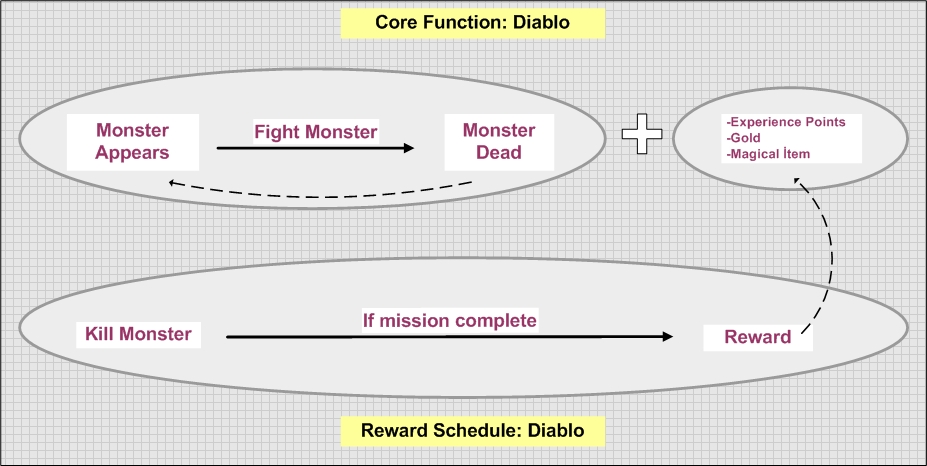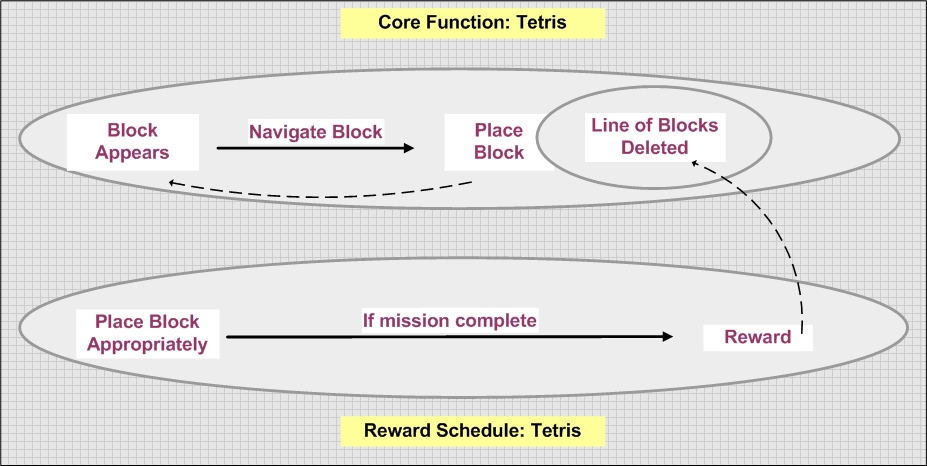
Featured Blog | This community-written post highlights the best of what the game industry has to offer. Read more like it on the Game Developer Blogs.
In this article I look at Diablo and Tetris to explain how both games match narrative structure and reward systems to achieve a high level of immersion.

In this article I will have a closer look at Diablo and Tetris in order to understand how reward structures and basic narrative bits interact to achieve high levels of immersion. First I will briefly explain reward schedules and core narrative functions. Then I will look into their relationship and state their major differences. Finally I will make a little comparison between the two games mentioned above and see how they combine reward structures and narrative bits for their own purposes.
Learning to do it Right: Reward Schedules
Most games are built around reward schedules. Reward schedules function as motivators for the players: The player carries out certain actions and gets rewarded for that. Hence, she continues to repeat the demanded actions. Such a schedule looks like this:

Schedule of Reinforcement
We can break down a reward schedule into the following elements:
Contingency: The problem that the player must overcome.
Response: The expected action from the player.
Reinforcer: The reward given if the expected action is carried out.
Basic Narrative Units: Core Functions
On the other hand, most games are also built around basic narrative units. These are called core functions. Core functions are a logically connected sequence of actions which amount to a unique event. Usually they are structured in a way that lets us experience climbing tension. A core function looks like this:

Core Function: A Basic Narrative Unit
Like in the reward schedule example, we can break down a core function to the following elements:
Challenge: The challenge appears in form of a threat or an enemy and comes (inescapably) at the protagonist
Struggle: The various actions that the protagonist carries out in an attempt to overcome the threat/enemy
Solution: The challenge is decided either for or against the protagonist
Gameplay Design: Combining Core Functions and Reward Schedules
Most video games feature a combination of core functions and reward structures. Both look very similar in nature, yet they are not completely the same and it can make a huge difference to the gameplay experience of your game if they're combined in different ways.
Note that a core function remains fully functional even if it does not reward the character at the end of the event. That is because the motivation for the character's action does come from a principle in drama called necessity (the fact that the challenge is inescapable, that it will keep coming at you whether you like to be involved or not). There is an external will that aims at you for its own reasons. Unless you don't break that will, you will continue to be subject to its (hostile) actions.
A reward schedule on the other hand is configured to stimulate certain actions. It is about learning to do the right thing and when that is achieved, a reward is given out. The reward plays a central role in motivation here (whereas in core functions the motivation is built on necessity and doesn't require an additional reward to be given when a solution is reached).
Since both build first and foremost on challenge, core functions and reward schedules will go parallel over most parts of the gameplay sequence that they create together, but usually the reward of the underlying reward schedule will come after the core function has been completed.
Two Examples: Diablo and Tetris
Let's have a look at how it is done in the game Diablo:

Core Function and Reward Schedule in Diablo
As can be seen here, gameplay equals to [Core Function + Reward]. Note that the narrative (core function) can live without the reward component, but that the reward schedule can't. On the core functions layer, Diablo makes use of reward schedules to foster short-term motivation. The joy that we derive from performing the core function (the narrative bit) is increased through the underlying reward schedule. However, the connection between the solution and the reward isn't an organic one.
The combination of narrative bits and reward schedules in Tetris works different:

Core function and reward schedule in Tetris
In Tetris we observe that the reward is much more integral to the narrative function. That is because learning the right behavior is not only a matter of getting rewarded for it, but it is also crucial in overcoming the narrative challenge in the game: Tetris' immediate challenge is based on deleting lines to withstand the pressure of falling blocks. In that sense, the game design manages to put forward a combination of reward structure and core function in which the reward is the solution. In other words, here, gameplay equals to [Core Function == Reward Schedule]
Combining Throughout Various Layers
Does this mean Diablo is not as cleverly designed as Tetris is? No, absolutely not. The comparison between the games is not complete without looking at the broader narrative layers and reward schedules that these fundamental layers are subordinated to. It is easy to see that Tetris has no such further layers. On the other hand, Diablo connects the rewards that follow the core functions in a much more integral way on an upper narrative layer, that of story person (or character). Rewards like experience points amount to a growth in the skill set of the character (we receive skill points that we can distribute on our character's attributes when we reach a new character level) and the gold and items that we receive amount to a growth in the inventory that we possess. In other words, rewards do not only motivate on the immediate core functions level, but their impact is also felt on broader tenses of gameplay. This results in an experience in which we feel that the core action gradually matures us into a full-fledged character. The pleasure that we derive from this is quite different from that of Tetris.
Conclusion
In this article I tried to illustrate how core functions and reward structures relate to each other and how different combinations create different gameplay experiences. The example was limited to an analyses on the basic layer and in the future I hope to delve into other layers to explain more complex relationships.
Resources
Barthes R. (1993). Göstergebilimsel Serüven [Adventures in Semiotics]. İstanbul: Yapi Kredi Yayinlari.
Hopson J. (2004). "Behavioral Game Design". http://www.gamasutra.com/view/feature/3085/behavioral_game_design.php?print=1
Read more about:
Featured BlogsAbout the Author(s)
You May Also Like








